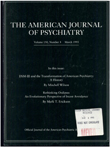Results of a survey of forensic psychiatrists on the validity of the sadistic personality disorder diagnosis
Abstract
OBJECTIVE: The purpose of this study was to determine how often forensic psychiatrists evaluated individuals with sadistic personality disorder; their views about the usefulness of the diagnosis; the frequency of certain childhood factors; and the sensitivity and specificity of the individual diagnostic criteria. METHOD: A questionnaire to be answered anonymously was sent to all of the 1,390 members of the American Academy of Psychiatry and the Law. Two hundred seventy-nine usable questionnaires were returned for data analysis. RESULTS: Approximately 50% of the respondents had, at some time, evaluated in a forensic setting a subject who exhibited behavior that met the criteria for the disorder. Four percent of the cases seen in the preceding year by those respondents who had ever seen a case would have met the criteria for the disorder. Most of the forensic psychiatrists who had experience with the disorder believed that the diagnosis is useful for a variety of clinical and forensic purposes, but most also believed that the category has significant potential for being misused in legal settings. Almost all cases described by the respondents involved male patients, and there was frequently a history of childhood abuse and parental loss. The diagnostic criteria in these cases had high sensitivity and specificity. CONCLUSIONS: In forensic settings the diagnosis of sadistic personality disorder is probably not rare. The results of this study suggest that the diagnosis has both descriptive and construct validity and that further study of the disorder with the DSM-III-R diagnostic criteria is needed.
Access content
To read the fulltext, please use one of the options below to sign in or purchase access.- Personal login
- Institutional Login
- Sign in via OpenAthens
- Register for access
-
Please login/register if you wish to pair your device and check access availability.
Not a subscriber?
PsychiatryOnline subscription options offer access to the DSM-5 library, books, journals, CME, and patient resources. This all-in-one virtual library provides psychiatrists and mental health professionals with key resources for diagnosis, treatment, research, and professional development.
Need more help? PsychiatryOnline Customer Service may be reached by emailing [email protected] or by calling 800-368-5777 (in the U.S.) or 703-907-7322 (outside the U.S.).



